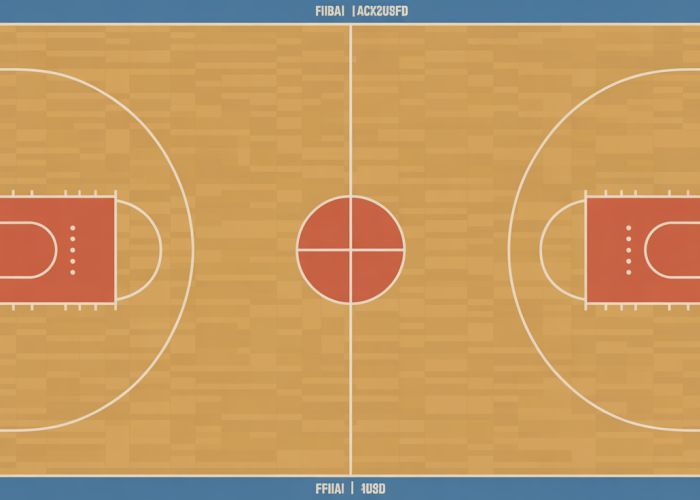The International Basketball Federation (FIBA), the global governing body, sets the standards for basketball, including the precise fiba dimensions basketball court. These dimensions, meticulously defined, ensure fair play across international competitions. Understanding these specifications is critical for everyone from the court construction engineer adhering to regulations to the national basketball team coach planning strategies. Knowledge of the fiba dimensions basketball court impacts game dynamics and strategic planning, demonstrating its significance for players aiming to compete on courts conforming to the official regulations.

Unlock the Secrets of FIBA Basketball Court Dimensions
This article dives deep into the specific measurements and key areas of a FIBA basketball court. Understanding these dimensions is crucial for players, coaches, and fans alike.
Overall Court Dimensions
The FIBA basketball court, unlike its NBA counterpart, adheres to a specific set of dimensions outlined by the International Basketball Federation (FIBA). These dimensions influence the gameplay and strategic decisions made on the court.
- Length: The court measures exactly 28 meters (91.9 feet) in length.
- Width: The width is precisely 15 meters (49.2 feet).
These dimensions define the rectangular playing surface within which all gameplay takes place. Any court used for official FIBA-sanctioned games must conform to these measurements.
Key Areas and Lines
Several important areas and lines are marked on a FIBA basketball court, each serving a specific purpose. These markings dictate player positioning, scoring opportunities, and potential penalties.
Center Circle
The center circle is located at the exact center of the court.
- Radius: The radius of the center circle is 1.8 meters (5.9 feet).
- Purpose: Used for the jump ball to initiate the game or after certain held ball situations.
- The circle is divided in half by a line that extends the width of the court.
Free Throw Lines and Restricted Area
The free throw lines and the restricted area (often referred to as the "key") are critical for scoring and defensive positioning.
- Free Throw Line Length: The free throw line is 3.6 meters (11.8 feet) long.
- Distance from Backboard: The free throw line is 4.6 meters (15.1 feet) from the backboard.
- Restricted Area: The restricted area is trapezoidal in shape. It extends 5.8 meters (19 feet) from the end line and is 4.9 meters (16.1 feet) wide at the free throw line.
- Restricted Area Arc: A semi-circle with a radius of 1.25 meters (4.1 feet) is drawn under each basket, restricting offensive players from remaining inside for more than three seconds.
Three-Point Line
The three-point line significantly influences offensive strategies, as shots made from beyond this line award three points instead of two.
- Distance from Basket: The three-point line is an arc located 6.75 meters (22.1 feet) from the basket. This is a relatively recent change, implemented by FIBA to slightly extend the range required for three-point shots.
- Straight Lines: From the end line, straight lines extend perpendicularly until they meet the arc.
Side Lines and End Lines
These boundary lines define the perimeter of the court.
- Side Lines: Run the length of the court (28 meters).
- End Lines: Run the width of the court (15 meters) and are also called baseline.
No-Charge Semi-Circle
- Radius: Is measured at 1.25 meters (4.1 feet) from the center of the basket.
Team Bench Areas
- Each team has a bench area on the side of the court where players can sit during the game.
- These areas are clearly marked and designated for team personnel only.
Technical Specifications
Beyond the fundamental dimensions, FIBA also specifies certain technical aspects related to the construction and marking of the court.
- Lines: All lines must be 5 centimeters (2 inches) wide.
- Color: The lines should be of a contrasting color to the court surface, typically white, yellow, or a light color that is easily visible.
- Materials: The court surface must be made of wood or a synthetic material. It must be flat, level, and free from any obstructions.
- Lighting: The court must be adequately lit to ensure visibility for players, referees, and spectators.
Understanding these technical details helps ensure fair play and optimal performance conditions.
Table of FIBA Dimensions Basketball Court (Key Measurements)
| Feature | Measurement | Metric (meters) | Imperial (feet) |
|---|---|---|---|
| Length | 28m | 28.0 | 91.9 |
| Width | 15m | 15.0 | 49.2 |
| Center Circle Radius | 1.8m | 1.8 | 5.9 |
| Free Throw Line Length | 3.6m | 3.6 | 11.8 |
| Free Throw Line Distance from Backboard | 4.6m | 4.6 | 15.1 |
| Three-Point Line Distance from Basket | 6.75m | 6.75 | 22.1 |
| No-Charge Semi-Circle Radius | 1.25m | 1.25 | 4.1 |
FAQs: Understanding FIBA Basketball Court Dimensions
Here are some common questions about FIBA basketball court dimensions.
What are the official FIBA basketball court dimensions?
The official fiba dimensions basketball court measures 28 meters in length and 15 meters in width. These dimensions are standard for all official FIBA competitions.
How do FIBA court dimensions differ from NBA court dimensions?
FIBA courts are slightly smaller than NBA courts. NBA courts are 28.65 meters long and 15.24 meters wide. While the difference isn’t huge, it can impact game play.
What’s the distance of the three-point line from the basket in FIBA basketball?
The three-point line in fiba dimensions basketball court is 6.75 meters from the basket for most of the arc. This changed from 6.25 meters in 2010 to the current distance.
Why is it important to understand the fiba dimensions basketball court?
Knowing the fiba dimensions basketball court is crucial for coaches, players, and officials. It allows for better strategy, gameplay execution, and accurate refereeing in international basketball.
So, now you know the ins and outs of the fiba dimensions basketball court! Go forth and use your newfound knowledge, whether you’re designing a new court or just dominating on the existing one. Have fun out there!



